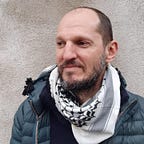Remembering Ibrahim Abu Thuraya: disabled Palestinian, rights activist, freedom fighter.
On January 10, a legal team representing the government of South Africa accused Israel of committing genocide against the Palestinian people in Gaza. Israel’s military campaign, which so far has killed more than 30000 people, injured above 70 thousand and displaced virtually every one of the 2.3 million Palestinians in the blockaded strip, enjoys the support of the United States and most western countries, through arms supplies, trade, regional military presence and diplomatic cover.
The 84-page document that South Africa presented to the International Court of Justice also included details of systematic targeting by Israeli snipers of children, disabled people, health workers and journalists predating October 7. Some of those examples go back to the Great March of return, in December of 2017. Citing multiple testimonies, the document describes rules of engagement adopted by the Israeli army during those popular demonstrations, which resulted in the killing of 214 Palestinian protesters, including paramedics, journalists, disabled persons and 46 children.
Ibrahim Abu Thuraya was one of the four targets selected by IDF snipers on December 15 of 2017. He was among the thousands of Palestinians marching from refugee camps all over Gaza to the fence that separates their blockaded land from Israel, protesting a decision by the United States to move their embassy to Jerusalem — a move stating the de-facto recognition of the illegally occupied city as Israel’s capital.
Mr. Abu Thuraya was a fisherman until losing his legs and a kidney to an Israeli airstrike that targeted the refugee camp where he lived, in 2008. Since then, he has become a staple presence in demonstrations against the Israeli occupation. Images of him jumping off his wheelchair and climbing up electricity poles to hang the Palestinian flag became symbols of defiance against the Israeli occupation, and of resilience in the face of its relentless brutality.
After the attack that left him disabled, Mr. Abu Thuraya recovered as countless other Palestinians who shared his fate: without support services, prosthetics, electric scooters, or accessible facilities, in a blockaded land commonly regarded as the biggest open-air prison in the world. As an activist, he changed disability perceptions in his community, showing that persons with disability can fight for freedom alongside all other members of the community.
His funeral was massively attended; his example and tenacious commitment to the struggle of his community widely celebrated in Palestine: a true statement of what the intersectional disability rights advocacy ought to be. As a Palestinian, Abu Thuraya’s life was marked by Israel’s colonial brutality, from its beginning at a refugee camp to the bomb that left him disabled, and his end in the crosshairs of Israeli sniper, who shot him in the head.
Tributes posted on social media and the multitude that accompanied his funeral procession across Gaza City drew international attention to his tragic story. Mainstream media ran stories about his life, and human rights organizations such as Amnesty, Human Rights Watch and the Israeli B’tselem called for an investigation of his case. Israeli journalist Gideon Levi wrote in Haaretz: “the killing of Ibrahim Abu Thuraya should bother anyone who cares about international law, justice, equality and human values.”
However — and despite of the prominence of his case — no one in the international disability rights community took any interest in him or the circumstances of his killing. Not a single mention of him can be found on the websites of the main organizations advocating for disability rights. And today, as those responsible for Abu Thuraya’s murder kill and maim countless more disabled Palestinians, the story repeats itself, as the main organizations of persons with disabilities seem only capable of perfunctory statements about Gaza’s genocide, if not avoiding the subject altogether.
Disability rights advocates must be reminded of the stories of Abu Thuraya, of Iyad Al-Halaq, and many other disabled Palestinian victims of Israel’s decades of colonial violence. Their lives and struggles are not only important in the narrative of the Palestinian quest for freedom, but also as an inescapable element in the DNA of disability rights as a social movement. Just like the experiences of figures like Judy Heumann and other activists who reached fame and international prominence, theirs deserve to be remembered and honored.
In the future, when historians recall the Israeli attempt to eradicate Palestinian life and culture, the current genocide will be just a chapter — albeit dire and particularly cruel. Other chapters will surely include the lives and struggles of Ibrahim Abu Thuraya and other disabled Palestinians like him, murdered while most of the world looked the other way.
